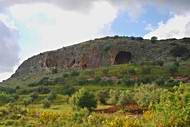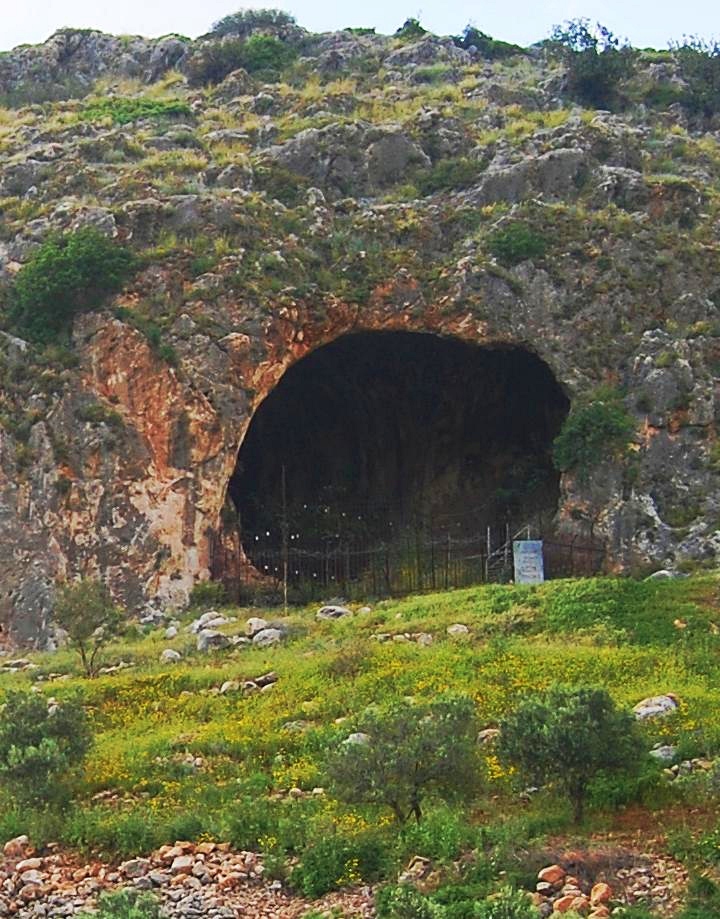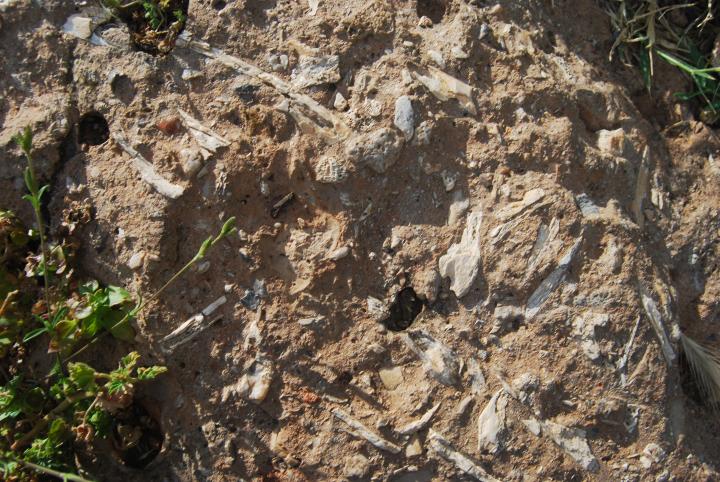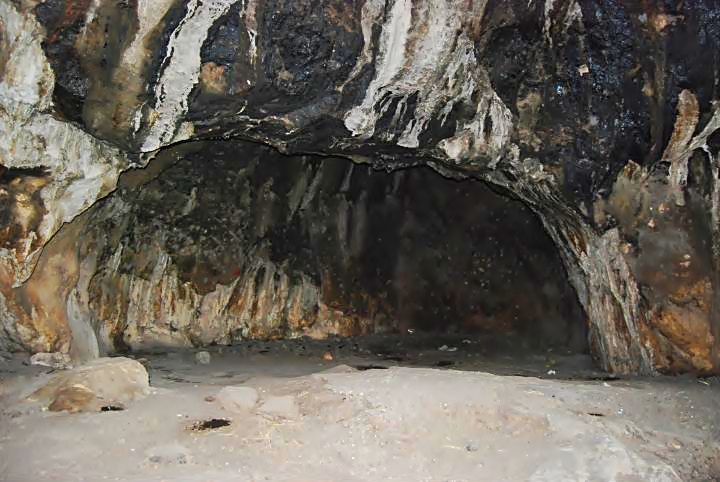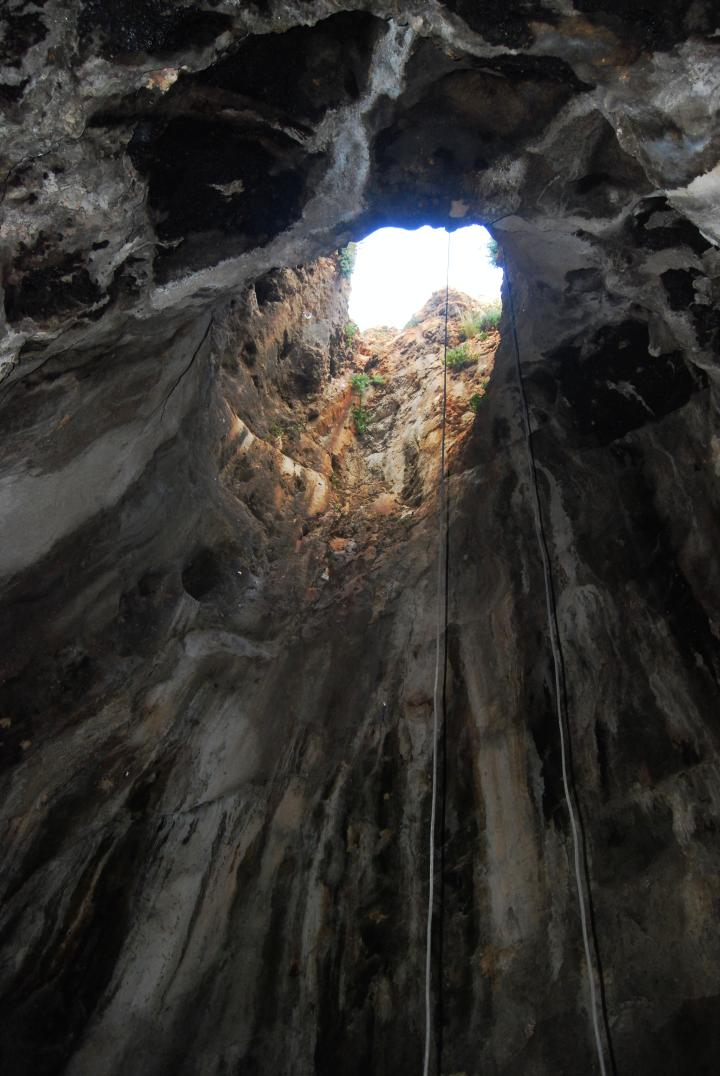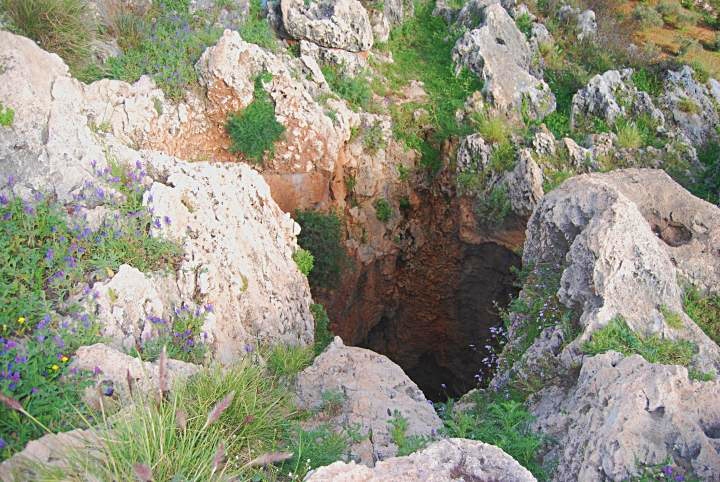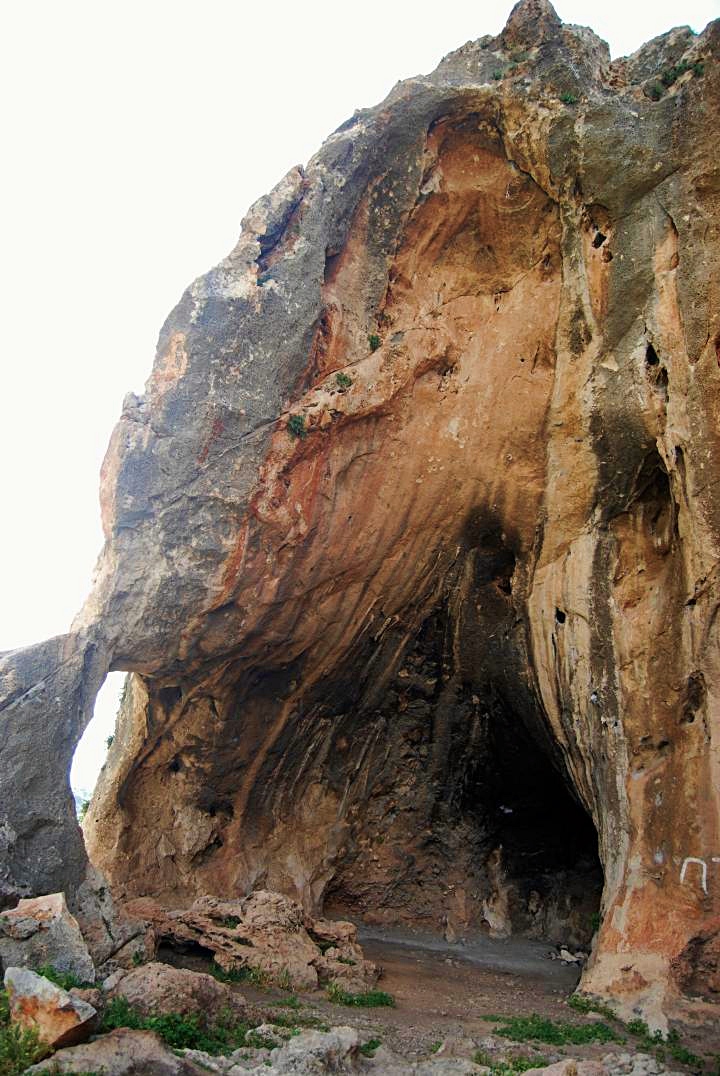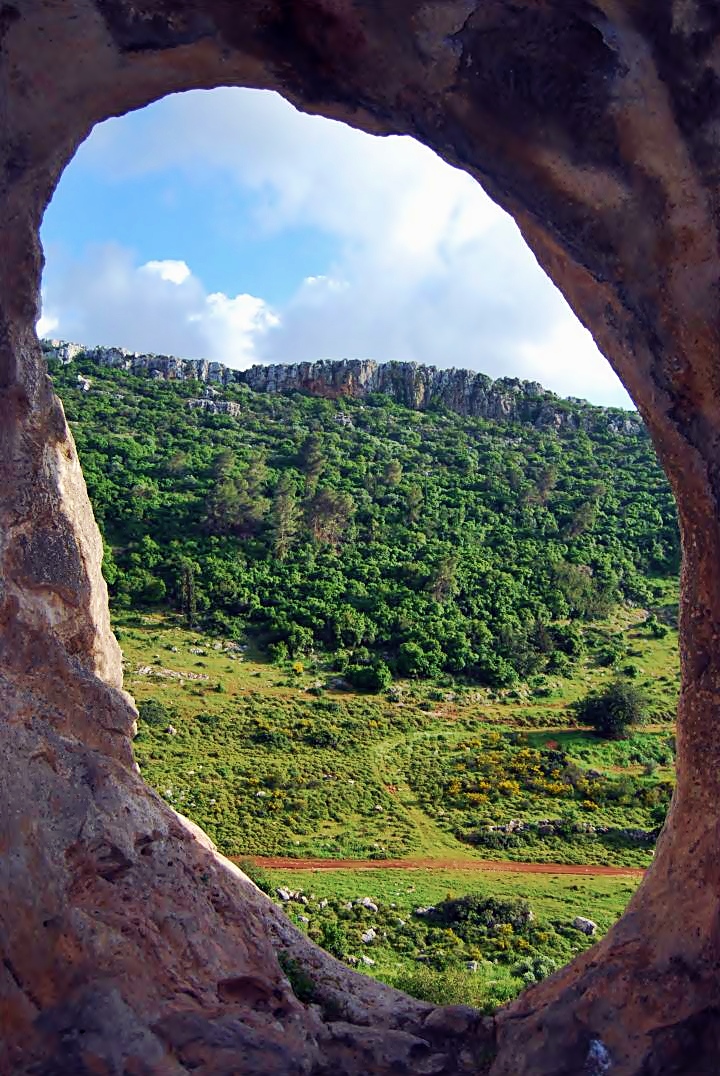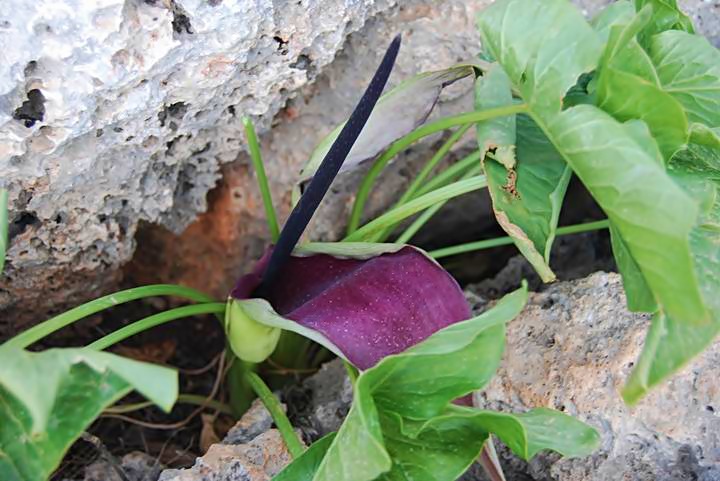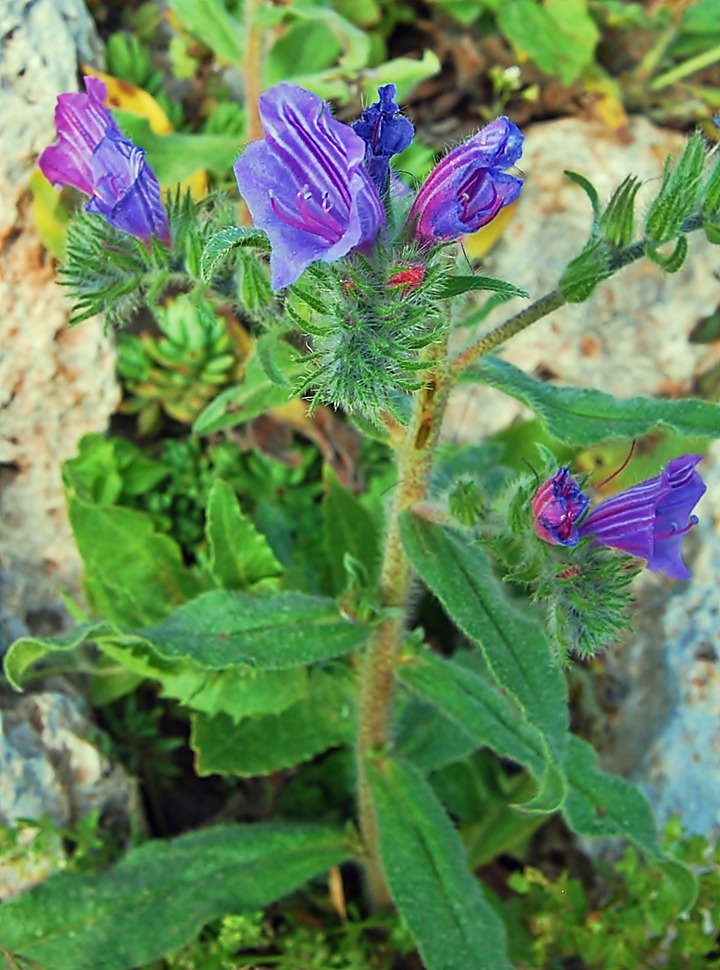A nature reserve on the western edge of Beit-Hakerem valley, with a cluster of caves with remains from prehistoric settlements.
Home > Sites > Beit Kerem > Pigeons Caves (Ma’arot Yonim)
Contents:
Background
Location
Prehistory
Photos
* Pigeons cave
* Eastern cave
* Center cave
* Western cave
* Nature photos
Links
Etymology
Background:
The nature reserve is located on the south-western edge of the Beit-Hakerem valley. On its north side is a cluster of caves (called Pigeons caves) with remains of prehistoric dwellings. On the south side is Har Gamal, which is detailed in a separate web page.
Location:
The aerial map below shows the site, in the center, from a north orientation. To get to the caves, turn left when arriving from Acre to the Gilon/Tzurit junction. There are two parking places – on the edge of the road just above the caves and on the north side of the road near the caves. Walk carefully down the path that descends down the cliff, following the white-red-white signs.
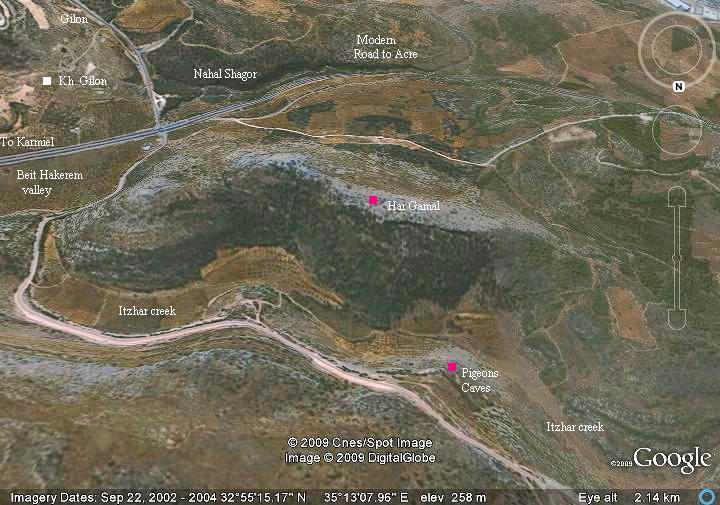
Prehistory:
The site has a long history of over 50,000 years:
-
Prehistory in the Galilee
The pigeons caves were the site of early man dwellings. It has three halls, and two others collapsed over time. The caves were used for dwellings and burial places for over 50,000 years.
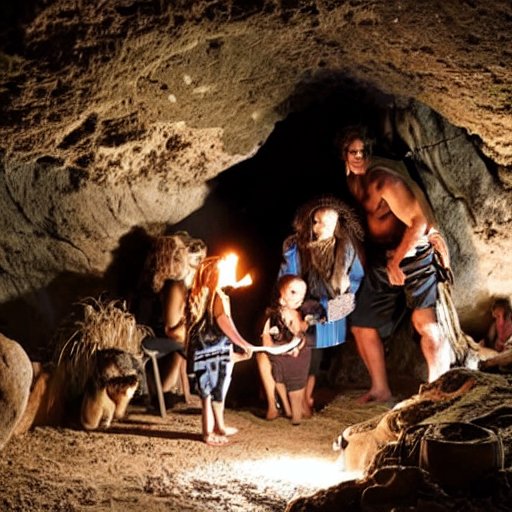
Early Man in a cave – AI generated by Stable Diffusion
The following describes the prehistoric settlements in the area:
The population in the Carmel and Galilee regions peaked during the Upper Middle Paleolithic period (50,000-40,000 BC), the Epi-Paleolithic period (16,000 – 8,300 BC) and the Neolithic period (8,300 -4,500 BC). There were fewer numbers in the Early Paleolithic period (150,000-80,000BC) and the upper Paleolithic period (40,000 – 16,000 BC). The other sites in this area were found near Kibbutz Evron and in the Carmel caves.
In the Middle Paleolithic period (80,000-40,000 BC) were the majority of the settlements. These people knew how to make knives, scrapers and points out of flint. There were two types found: Homo Sapiens (our ancestors) and the Neanderthals (the specie that eventually disappeared – Thanks for Jeff Robins for the correction). Note that this time coincided with the last Ice age (100,000 to 10,000 BC), and so the climate was wet and cold.
In the later periods, the Epi-Paleolithic period (16,000 – 8,300 BC) and the Neolithic period (8,300 -4,500 BC) the early man already domesticated plants and animals. The type of early man that was found from this period was the archaic Mediterranean type, with average height of 160-165 cm.
- Later periods
In the later periods, the Epi-Paleolithic period (16,000 – 8,300 BC) and the Neolithic period (8,300 -4,500 BC) the early man already domesticated plants and animals. The type of early man that was found from this period was the archaic Mediterranean type, with average height of 160-165 cm.
As for the later periods from the Israelite period to modern days – check the web page of the nearby Har Gamal.
- Excavations
Photos:
Credit – Thanks for Jack Elliot’s corrections and guidance
(a) General view
The “Pigeons Caves” are located on the north side of the Yitzhar valley across from Har Gamal. They served as shelter for early man during the upper Middle Paleolithic period (50,000-40,000 BC) and during the Kebaran and Natufian periods (12,000-8,300) of the Epi-Paleolithic.
Click on the photos to view in higher resolution…
(b) Eastern cave
The eastern cave is sealed with a metal fence due to safety reasons. The markers used by the archaeologists are seen inside the cavity. The cave is swarming with bats, swallows, and pigeons, and consequently sounds like a noisy music box.
The photo below shows a detail of the terrace in front of the cave. The surface here includes what appears to be a mixture of bones and other small objects.
(c) Center cave
The photo below shows the entrance to the middle cave. As seen on the bottom left side, this is a favorite place for rappelling.
The middle cave has a cluster of rooms. A view inside one of these rooms is seen below.
The photo below is a view from another room inside of the cave, but looking up. There are rappelling ropes here too for an “inside job”.
The photo below shows the vertical shaft that leads down into the cave.
(d) Western cave
The western cave has partially “caved in” and only parts of it remained.
The photo below shows an interesting “key-hole” view from the cave towards Har Gamal.
(e) Nature photos:
Around the cave are many species of wild flowers and plants (see references below for more information):
-
Israeli Luf
The photo below is the “Israeli Luf” (Arum Palaestinum, of the Araceaes) which flowers during months Feb-April. It is toxic (poisonous Aroin), although during the second temple period the farmers knew how to cook it safe (as written in the Mishna).
- Achna’i
The flowers below blossom during spring and summer, and this shrub is known as Achna’i (in Hebrew) or: Hispid Viper’s-bugloss (Echium Angustifolium). The flower changes color from pink to blue after a day or soon after it is cut. A new flower replaces the previous flower each day.
Links and references:
Doves cave:
- Hayonim cave excavations – facebook of 2022 renewed excavations
-
Acheulo-Yabrudian and Early Middle Paleolithic at Hayonim Cave: Continuity or break? [Liliane Meignen, OferBar-Yosef {JHE 139, 2020)]
Prehistory:
- Prehistoric sites in Israel – overview and sample sites of prehistoric sites
- Prehistoric Tools – info page on early man tools
Har-Gamal:
-
“Looking for The Source” article by Jack Elliot, identifying Har-Gamal as the source of Michener’s great novel, and Pigeons caves as source for the prehistoric section.
Flowers:
Rappelling in Biblical sites:
Etymology (behind the name):
- Ma’arat Yonim- Pigeons cave: Yonim – pigeons, Ma’ara – cave, Ma’arot – caves.
- Har Gamal – Hebrew for “Mt Camel”: Gamal – Camel (since it has a form of a double-hump camel); Har – mountain
- Yizhar creek (Itshar) – Hebrew for high quality olive oil; the name of the creek on the north side of Har-Gamal. Named after the olive oil production in the area. Its Arabic name is “Wadi El-Amik” – the deep valley. It is indeed deep between the mountains.
- Beit Kerem (BethCerem) – Hebrew: House of the vineyard (or grove).
BibleWalks.com – touring the sites of the Holy Land
Har Gamal<<<–previous site—<<<All Sites>>>— next Beit-Kerem site –>>> Kh. Madarasah
This page was last updated on Mar 18, 2023 (AI illustration)
Sponsored links:
